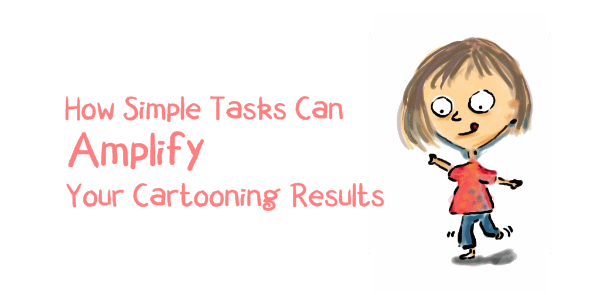The year was 2011 and I was in rehab – recovering from a hip operation. I wanted to return to running strength as fast as possible, but bending at the knee – slowly and with control – was still a tall order.
“Lunges are too big a movement. Simply stand on your left leg, bend slightly at the knee and return to the standing position. Slowly and with control. Ten times a day, till I see you next week”. So said the physiotherapist.
The remarkable thing was that by the following week, I could see a marked difference in how stable my leg was – and that was not the only improvement.
Students on the Da Vinci cartoon course relate to this story
They know all about simple cartooning tips that have far-reaching results and that’s because Da Vinci-ites start off simply drawing circles. And making observations about the process. It’s part of the methodology that we use.
“Trust the Process” is an catch phrase, alongside numerous cartooning tips
Yep, for a whole week, the students circle and circle in their notebooks (or on scrap paper, or tablets). Large, small and medium circles. Fast and slow pencil speeds. Clockwise and counter-clockwise. For the really diligent ones, we have to rein them in to make sure they don’t get overuse injuries in their wrists (for reals!) And all the while they’re aiming for control, and engaging in self-observation.
Why do they draw circles, only circles, observing all the time?
Well, there’s one main reason and that is to internalise the reality that the ‘pros’ always start out by sketching up a storm, whereas amateur doodlers tend to use a single line and expect to get it right the first time. That’s the first big difference between those who can draw and those who cannot.
At least that’s the main purpose of the exercise.
In the first Da Vinci course, way back in 2010, there was no other reason. But over the years its become apparent that loads of other benefits that ripple out from this exercise each year. Observing your own learning while engaging fully in a simple task is fascinating in the depths of what it can reveal (but that’s really a topic that deserves its own article, some other day)
So what do the students learn from such a simple task?
Yes, they learn how to sketch circles, with a lot more control. But they also learn countless other things. For example, they learn that circling can be a meditation at the end of a stressful day, so doing the work is its own reward. They learn to have fun in the doing – don’t put pressure on yourself, just continue doing, and eventually you’ll be done. They learn that 5 days of daily practice is enough time to see and feel visible results. (much like doing hip strengthening exercises!)
Of course there are other results more closely aligned to drawing cartoons
- They learn how to hold their pencils without strain. (you’d be surprised how important this is, given our stress-filled, goal-oriented lives)
- They learn to balance drawing control with loose sketchiness.
- They learn to draw different circle sizes, in different directions, at different speeds, all with growing ease.
So what?
You may be thinking “This is all very interesting (yawn) but they have still only mastered circles, for goodness’ sake!” And you’d be dead wrong in that. They’ve certainly mastered circles and they have also begun on a journey that will change the way they view the value of simple tasks. As they continue to engage deeply with their asks, they will be embracing cartooning tips and practices that will ripple out and enhance the way they work (and play) for years to come.
The human brain is a remarkable piece of unfinished business
There is no question but that you can always treat an old dog human new tricks and you just never know quite what people will discover about themselves. It’s one of the endlessly fascinating parts of teaching different cartooning groups each year. It’s given me a infinite respect for the human brain, and the power of a curious mind to go anywhere.
Is the task too simple?
That’s for you to decide. But the latest crop of Da Vinci students would argue that even the simplest task can offer a wealth of learning.
What can you ‘watch’ yourself do today?

